30-second summary:
- A traffic drop doesn’t necessarily mean something is wrong – in most cases, it is natural
- All sites have experienced a decline in traffic throughout their lifetime which can be explained by seasonality, loss of PPC budget, and many other factors
- When it comes to organic search traffic decline, it is often caused by stagnant content, the emergence of new competitors, or loss of backlinks
- To diagnose a traffic drop, identify which traffic source is declining, then find which pages have lost traffic
- It is important to avoid hasty decisions, take your time exploring whether you lost any positions and which pages replaced yours
- Try to evaluate why this shift has happened and how you may fix it
Have you ever checked your analytics and saw a sudden or gradual decline in organic traffic? Who hasn’t? If there’s one common thing in just about any marketing strategy: All of us have dealt with organic traffic decrease on many occasions. Any website out there has seen traffic dips, often even regularly.
How to deal with organic traffic decline when you see something like this inside your Google Analytics?
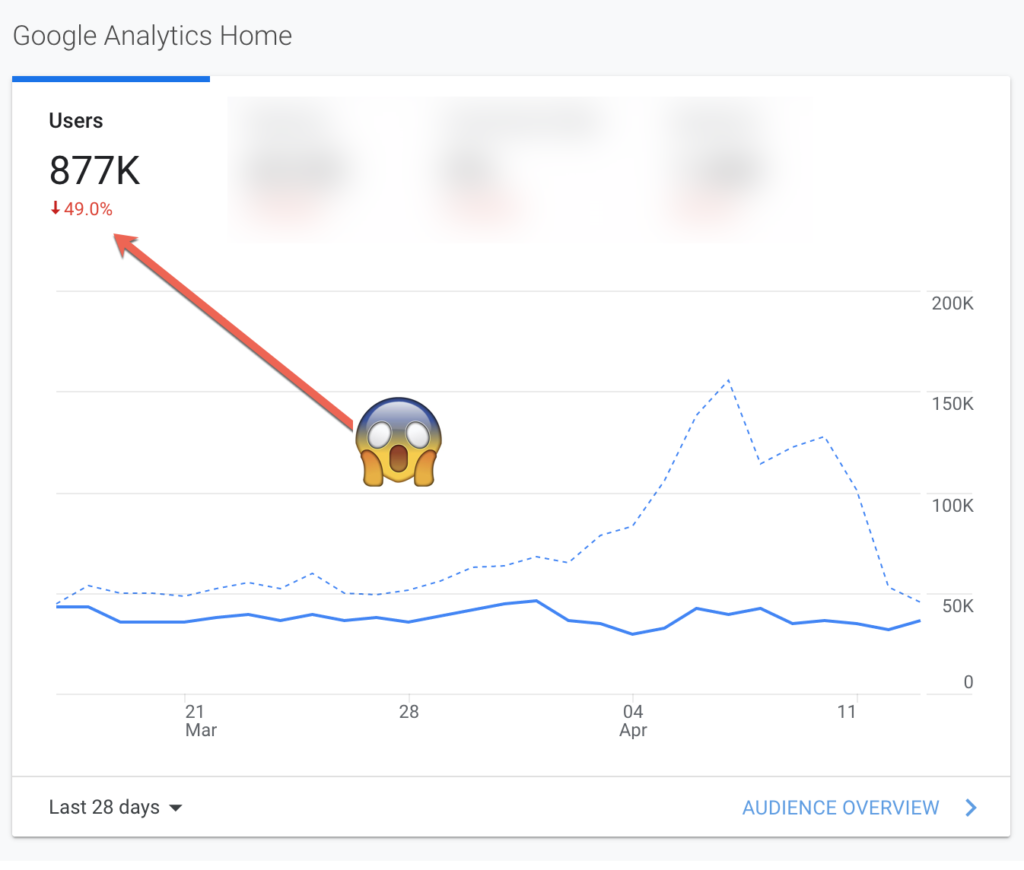 Image source: Screenshot made by the author (April, 2021)
Image source: Screenshot made by the author (April, 2021)
Here are four well-defined steps to take when diagnosing a traffic drop:
Step 1: Check which traffic source was effected
This is an obvious one but too many people automatically assume it’s Google organic traffic that has dropped.
So make sure it hasn’t been PPC traffic that has exhausted your budget. This happens more than you think!
So assuming, it is organic traffic, let’s go on checking:
Step 2: Which page has dropped?
To quickly find out which pages dropped, navigate to your Google Analytics account Acquisition -> All Traffic -> Channels. Click “Organic” there and in the date range, check “Compare to” and in the drop-down select “Previous period”:
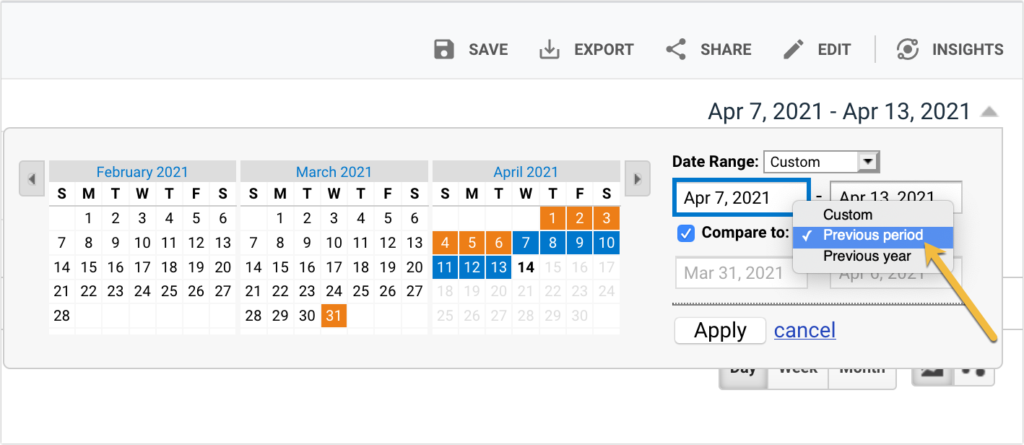 Source: Screenshot made by the author (April, 2021)
Source: Screenshot made by the author (April, 2021)
Now scroll down and click the “Landing pages” tab to see all your pages and how their traffic of this week compares to the previous week.
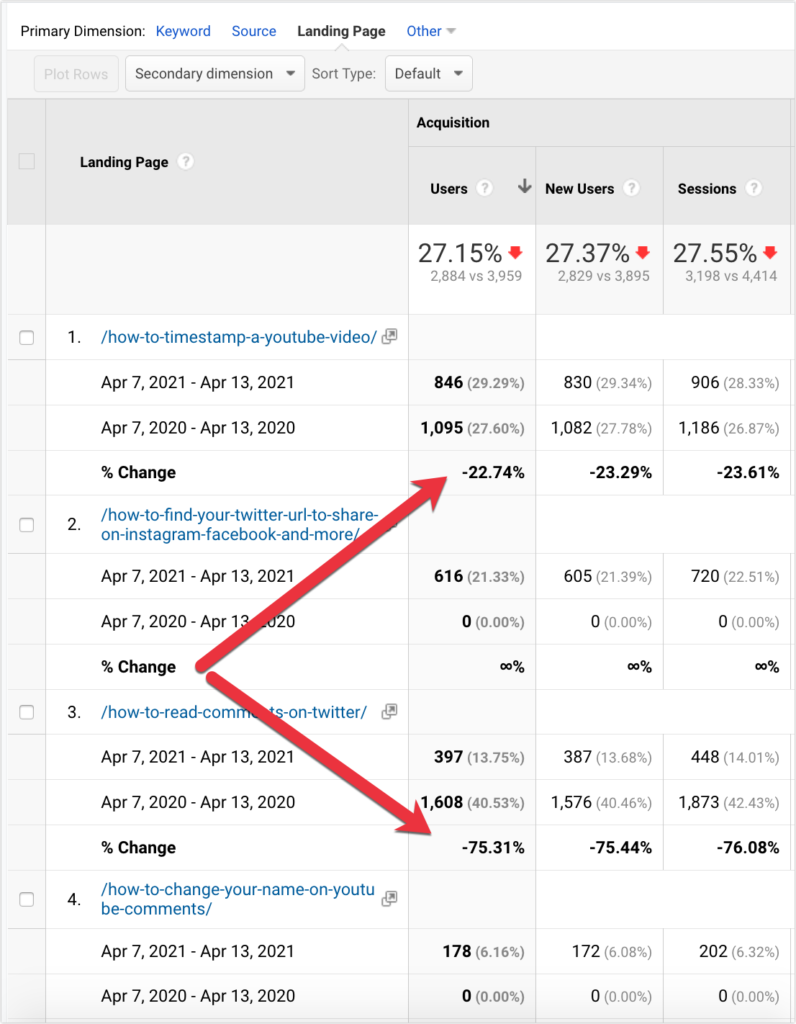
Source: Screenshot made by the author (April, 2021)
No need to scroll a lot here. If you see a traffic dip, chances are, your higher-ranking page or pages were affected. So look at the top of the list.
Now, most importantly, if all your pages took a hit, that’s a good reason to worry. This may be an indicator of a site being affected by a recent Google Update or even a penalty (the latter is much less common these days). This article lists a few good ways to research whether there was an update and how to evaluate whether you may have been affected.
A more common scenario is that you will see some pages dropping. Others will remain intact or even start gaining in traffic. This is a good indicator you shouldn’t be worried about any possible action from Google. Most pages go up and down search engine result pages all the time.
Now, you grab the list of declining URLs and research them further.
Step 3: Was there any impact on rankings?
It is not such a rare thing: We see a gradual decline in traffic without any obvious impact on rankings. This can be explained by two possible reasons:
- People just don’t search for that query that much anymore. This was very common in 2020 when searching patterns shifted dramatically. And this can still be the case for seasonal queries (think “costumes,” “ski gear”, “swimsuits,” etc.)
- Search engine result pages have added a new search element that steals attention and clicks.
So how do you diagnose if your rankings drop?
This question is harder to answer these days. If you are monitoring your rankings, an obvious step here would be to go check there.
Google’s Search Console is another platform to check but it is not easy to quickly diagnose the ranking drop there. The tool is a little behind in showing data. Still, if you give it some time, you can analyze your rankings thereby using “Compare” tab within the “Performance” section of the reports:

Source: Screenshot made by the author (April, 2021)
Once you choose your date range, scroll down to your data and filter it by the “Position difference” column.
Mind that all you need to note here is lost or declined first-page ranking because your second-page rankings wouldn’t have driven traffic to lose anyway. So again, breathe.
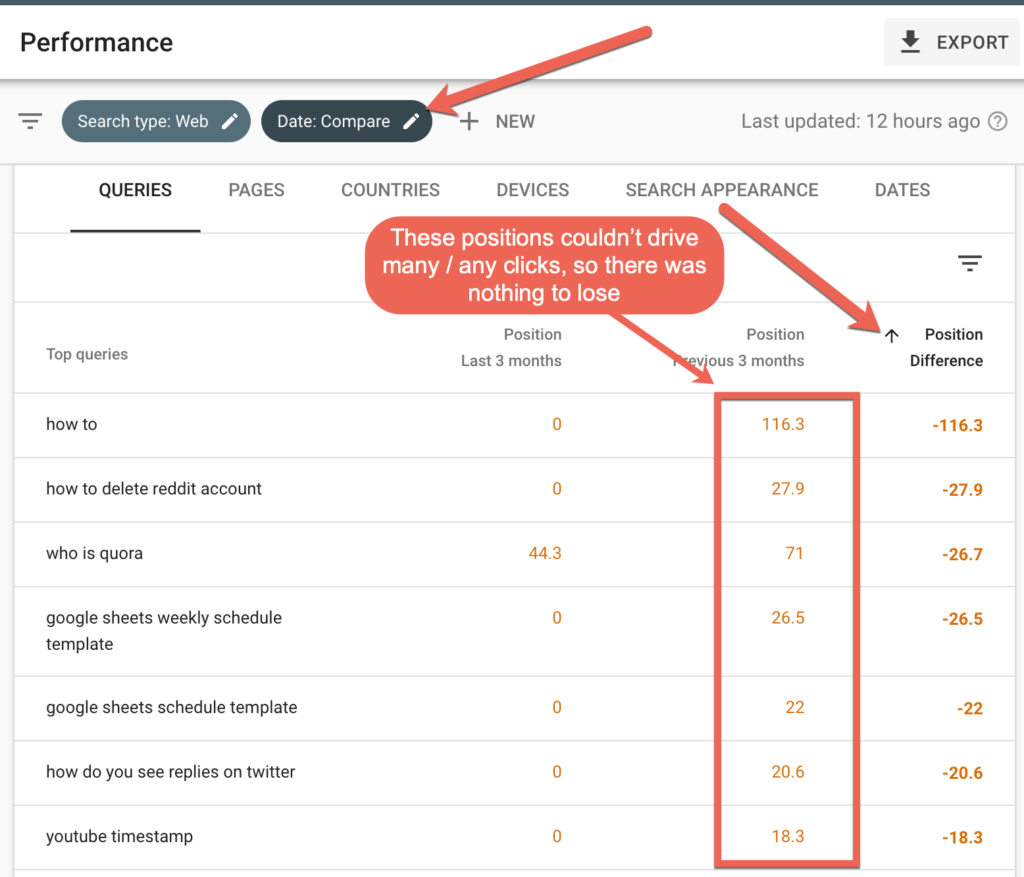
Source: Screenshot made by the author (April, 2021)
Instead, you can filter Search Console data by “Previous positions” to see, for example, lost #1 rankings:

Source: Screenshot made by the author (April, 2021)
Another – probably smarter – way to diagnose hit queries is to judge by traffic. Search console shows the number of clicks each query is sending and how it compares to what it used to send. If Google is not the only search engine you are concerned about, using Finteza you can spot search queries that are sending less traffic than they used to:
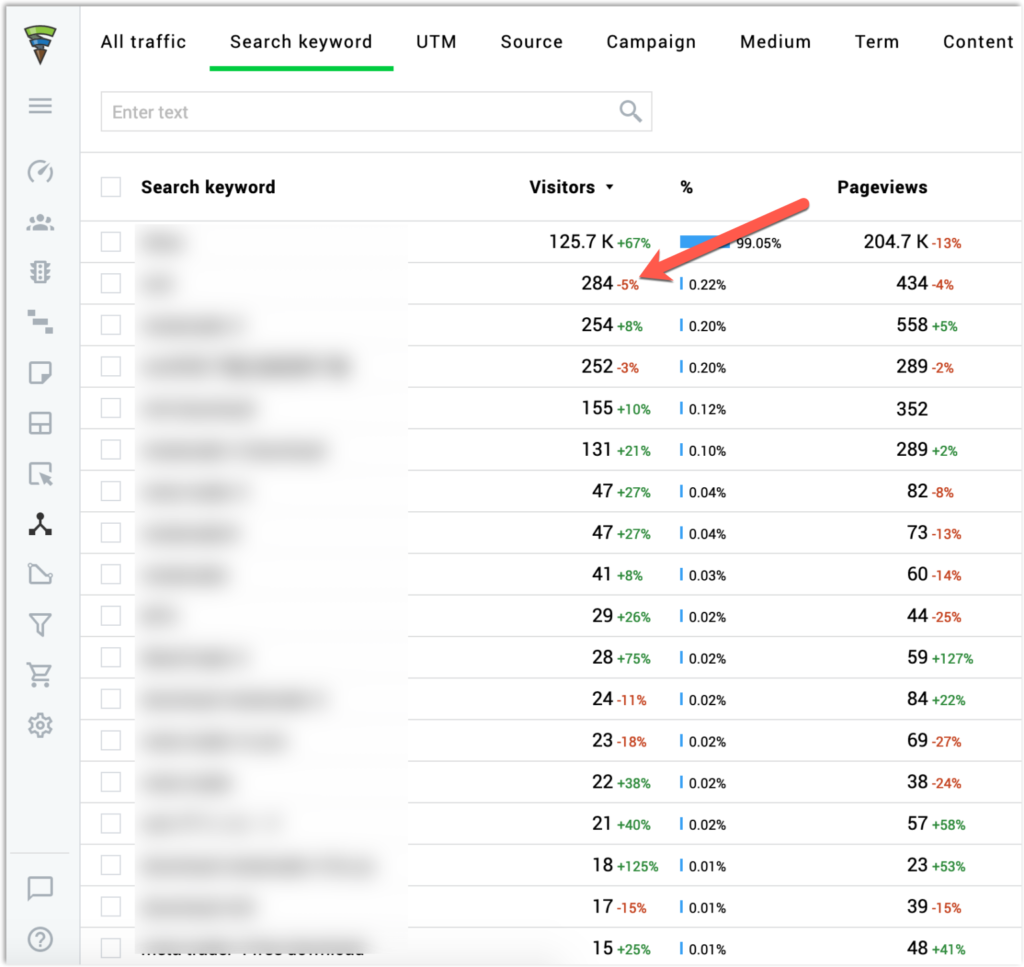
Source: Screenshot made by the author (April, 2021)
Finteza’s default search keyword report consolidates data from all search engines you appear in. You do need it running for some time to accumulate this data. It is easy to integrate.
Finteza is paid (costs $25 per 100,000 unique users a month) but it is the only web analytics solution that still offers reliable keyword data.
For a better understanding of what is going with your organic traffic, I suggest using all of the above (and more) methods. Again, with search personalization and localization, it is very hard to understand where you are gaining (or losing) from, so combining data from multiple sources is the key.
Step 4: Identify why these ranking dropped
Here comes another tedious part in our analysis. More often than not, your rankings may fluctuate or drop due to Google finding a better page to rank. This may happen because:
- Your query deserves freshness and there is a fresher page that was boosted on top of yours. If this is the case, you’d have got used to fluctuations by now.
- Your competitor created a better page that has better backlinks.
- You have lost some important backlinks which has led to losing some equity
Your position monitoring solution may give you some clues as to which page has overcome you in SERPs. Most rank monitoring platforms come with “SERP tracking” feature that grabs a snapshot of your important SERPs on a regular basis.
You can monitor your target SERP movements for you, for example:
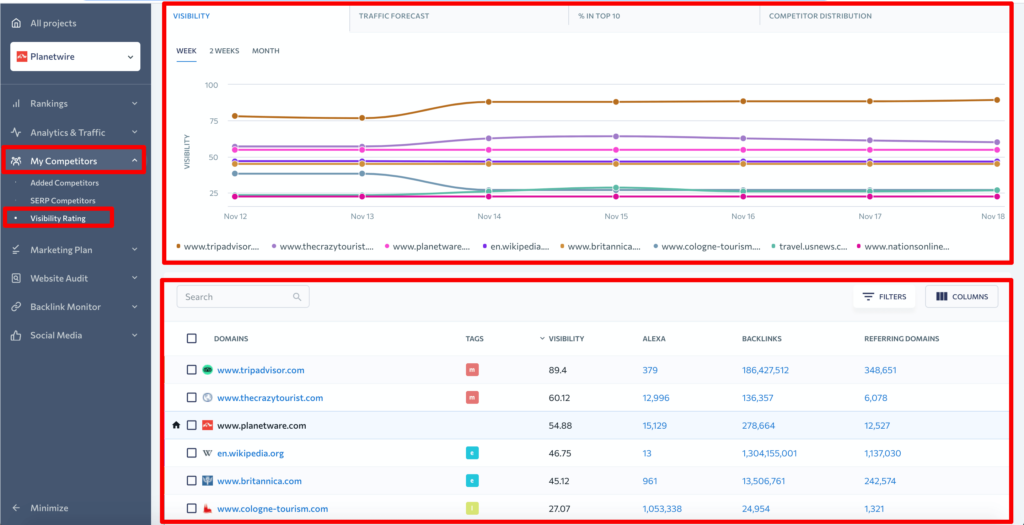 Source: SE Ranking
Source: SE Ranking
For high-search-volume queries, SpyFu is keeping a record of key SERP movements:
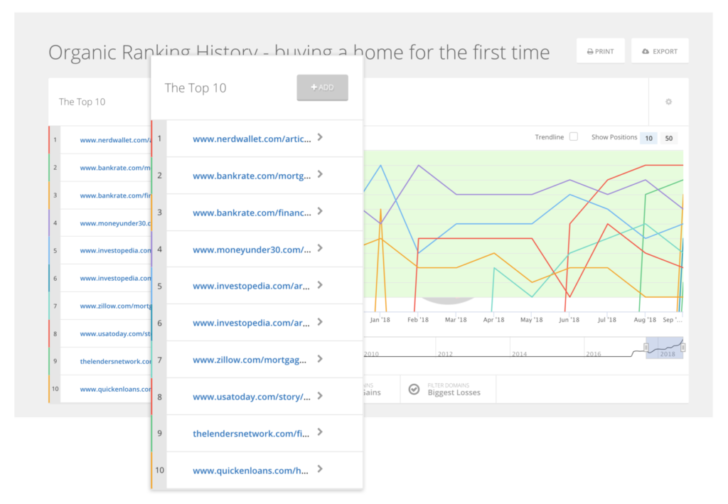 Image source: Spyfu
Image source: Spyfu
To make it easy to spot your lost backlinks that may have accounted for declined positions, use link monitoring tools. They keep a record of when exactly each link was lost, and so make it easy for you to evaluate if this is what may have had an impact on your rankings and organic traffic:
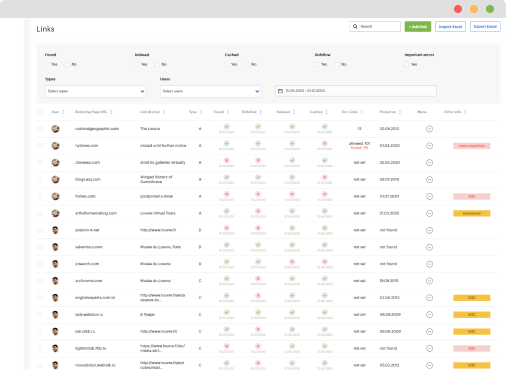 Source: LinkChecker.pro
Source: LinkChecker.pro
When you know which page is replacing you in search results, try to find why. There can be an array of reasons, including the most common ones (as well as the combination of such):
- Fresher content
- Better (longer, higher-quality, more visual, more in-depth, etc.) content. Here’s how to analyze and improve.
- Better optimized content
- More semantically relevant content. Here’s how to diagnose and improve.
- Better (and yes, more) backlinks. Here’s a list to find and compare backlinks
- More trusted content (May be connected to backlinks but also authorship)
- Better referenced internally. Here’s how to analyze to improve
Conclusion
Keeping your traffic in control is beyond your powers. What you can do is to keep an eye (building a dashboard would make it easier and more consistent) as well as create a well-set routine for analyzing a possible dip.
When you see organic traffic decline or dip, it doesn’t usually mean that your site is under any kind of filter or penalty (which is most often assumed). In most cases, this is a perfectly natural on-going SERP fluctuation. Stay calm and carefully analyze what has changed (and why). Don’t rush to take any action or fix anything until you check various data sources and take time to come up with a strategic plan. And most importantly: Just breathe!
The post Diagnosing a traffic drop? Just breathe! appeared first on Search Engine Watch.
No comments:
Post a Comment